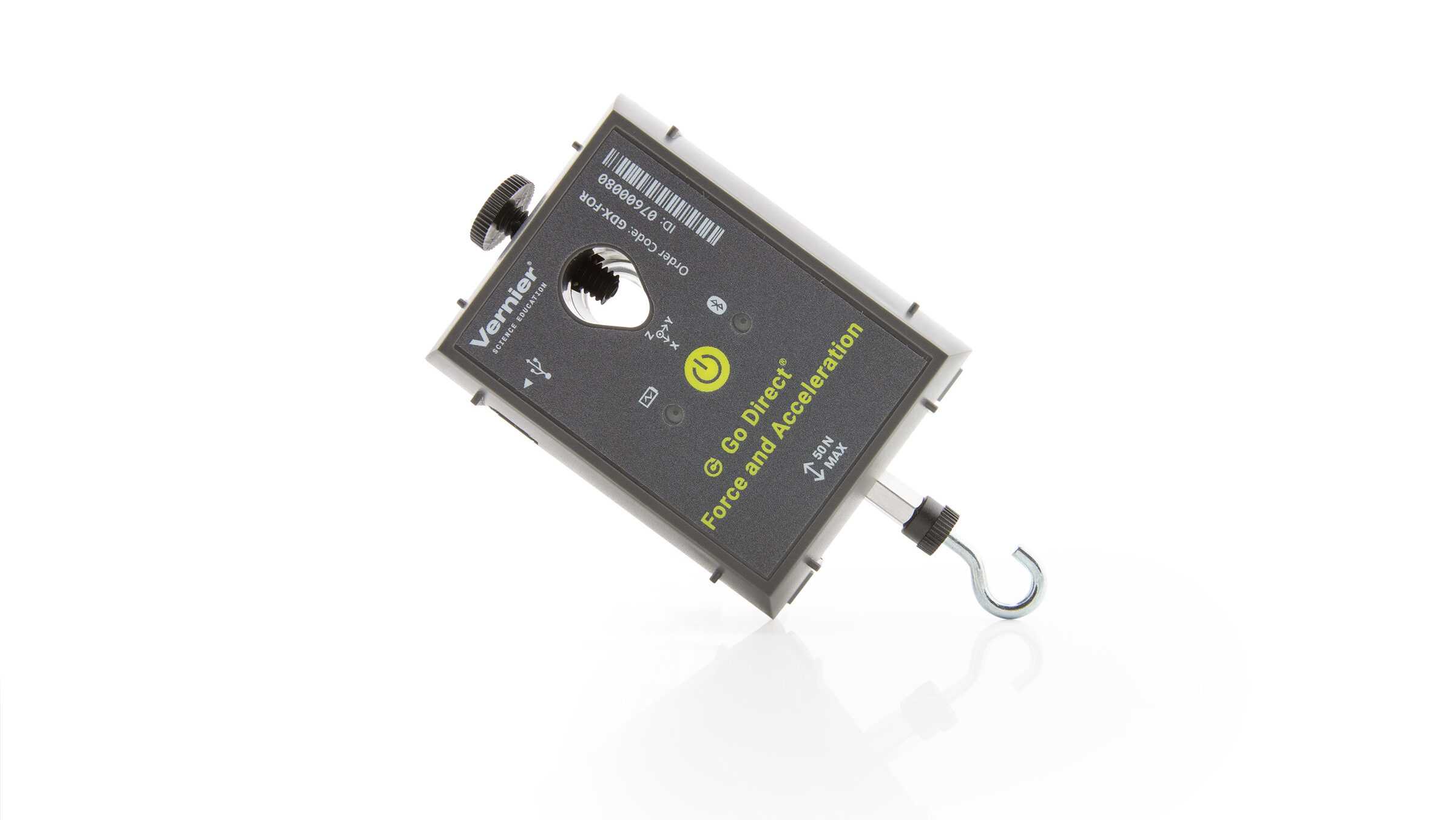Troubleshooting
General: Press the power button on the sensor to turn it on. Connect your sensor as described in the Getting Started instructions for your device.
- Force Sensor
- Does the sensor read near zero when no force is applied? Does the sensor read a positive value when pulling, and a negative value when pushing?
- Point the hook downward. With nothing attached, note the force reading. Then hang a 500 g mass from the hook and note the new reading. Is the difference approximately 4.9 N?
- Was the force sensor properly zeroed? In general, before collecting data you should zero the force sensor in the orientation in which you want to use it, with no force applied. This additional step makes force measurements more accurate.
- Accelerometers
- When placed on a flat surface with the label up, do the accelerations in the x- and y- directions read approximately zero, and does the acceleration in the z-direction measure -9.8 m/s2?
- Were the accelerometers properly zeroed? For more accurate acceleration readings, zero the x- and y- directions of acceleration while the sensor rests horizontally on its top or bottom surface. Zero the z-direction of acceleration while the sensor rests horizontally on one of the long, rounded sides. Narrow “feet” on the rounded sides make this step easier.
- Gyroscope: Zero unit while it is at rest on a surface. Then shake unit in one hand while collecting data. Are there readings?
Additional Troubleshooting
- How can I change the sign of the force reading? (Make either push or pull positive or negative)
- What replacement parts are available for the Force Sensor?
- What is the thread on the bumpers and hooks for Vernier Force Sensors?
- Which version Dual-Range Force Sensor do I have?
- What does an accelerometer actually measure?
- How do I connect the Go Direct Force and Acceleration Sensor to a plastic Vernier dynamics cart?
- When collecting force data, why aren't the measured impulses synced?
- How can I make my own hoop bumper to use with a Vernier force sensor?
- Go Direct Sensor always reads zero (or some other constant value).
- Go Direct sensor does not connect to LabQuest 2 via Bluetooth.
- How do I remove or replace a Go Direct battery?
- Troubleshooting Bluetooth Connections with Go Direct Sensors
- What can I do if a Go Direct sensor's Bluetooth LED flashes red and green when I try to connect to it and the connection fails?
- Will my device work with Go Direct Sensors via Bluetooth?
- How do I know if my LabQuest will work with Go Direct Sensors and Go Wireless devices?
Specifications
- Response time: 1 ms
- Force range: ±50 N
- Acceleration (3-axis) range: ±156.8 m/s² (±16 g)
- Gyroscope (3-axis) range: ±34.9 rad/s (±2000°/s)
- Maximum sampling rate: 1000 samples/s
- Dimensions:
⚬ Length: 7.6 cm, not including the post or hook or bumper
⚬ Width: 5.7 cm
⚬ Height: 3.3 cm - Accessory Threading
⚬ Hooks and Bumpers: 6 – 32 thread
⚬ Accessory Rod: ¼ – 20 thread - Connections:
⚬ Wireless: Bluetooth® v4.2 (wireless range 30 m unobstructed)
⚬ Wired: USB 2.0 full speed - Battery: 300 mAh Li-Poly
⚬ Battery Life (single, full charge): ~10 hours continuous data collection
⚬ Battery Life (lifetime): 2 – 5 years (typical)
Calibration
FORCE SENSOR
Calibrate? Generally, no. This sensor is factory calibrated. However, the sensor may need re-calibration at some time. For more information, see How do I calibrate my sensor?
- Two Point Calibration
⚬ First Point: no force applied
⚬ Second Point: a known force applied. We recommend a 1 kg mass (9.8 N).
Do not exceed the maximum of 50 N during calibration. - The Force Sensor can be zeroed.
This is useful after calibration to remove the weight of the hook. - The Force Sensor can be reversed so that push is positive.
ACCELEROMETERS (X-, Y-, and Z-AXIS)
Calibrate? Generally, no. This sensor is factory calibrated. However, the sensor may need re-calibration at some time. For more information, see How do you calibrate an accelerometer?
- Two Point Calibration
⚬ First Point: accelerometer aligned perpendicular to Earth’s gravitational field. (0 m/s²)
⚬ Second Point: aligned parallel to Earth’s gravitational Field. (± 9.8 m/s² depending on orientation) - The Accelerometers can be zeroed.
GYROSCOPE (X-, Y-, and Z-AXIS)
Calibrate? No. The gyroscope is factory-calibrated and there is no user-calibrate option.
Battery Troubleshooting
- If the sensor can be turned on when connected by USB but not when disconnected from USB, the battery likely needs charging.
⚬ Charge the sensor for several hours and try again. - If the sensor shows fully charged but still won’t turn on when connected via USB, then the battery has likely disconnected.
⚬ Check the battery connection. - If the sensor still won’t turn on, try swapping the battery with a working sensor to see if the problem follows the battery or stays with the sensor.
⚬ If the problem stays with the sensor, the battery is probably not the issue.
⚬ If the problem follows the battery, the battery has likely reached its end of life. - If the battery is indeed at the end of its life, the sensor cannot be used even if connected by USB, so the battery will need to be replaced. Go Direct® 300 mAh Replacement Battery (
GDX-BAT-300 ) - See How do I remove or replace a Go Direct battery? for more information (including a video).
Rechargeable batteries are covered by a one-year warranty.
Batteries should last two to five years in typical use.
Related Products
- Micro USB to USB-C Cable (
CB-USB-C-MICRO ) - Go Direct® Charge Station (
GDX-CRG ) - Reflex Hammer Accessory Kit (
RFX-ACC ) - Bumper and Launcher Kit (
BLK ) - Clay-Holder Bumpers with Clay (
CLAY-BMPRS ) - Magnetic Bumpers (
MG-BMPRS ) - Hoop Bumpers for Bumper and Launcher Kit (
HOOPS-BLK ) - Air Track Adapter (
ATA-DFS ) - Force Table Adapter (
FTA-DFS ) - Adapter for PASCO Cart (
PCA-DFS ) - Centripetal Force Apparatus Sensor Bracket (
CFA-SBK ) - Go Direct® Centripetal Force System (
GDX-CFA ) - Go Direct® Force Plate (
GDX-FP ) - 3-Axis Accelerometer (
3D-BTA ) - Dual-Range Force Sensor (
DFS-BTA )
Replacement Parts
- Go Direct® 300 mAh Replacement Battery (
GDX-BAT-300 ) - Micro USB Cable (
CB-USB-MICRO ) - Replacement Rod, 5 inch (
ACC-ROD ) - Dual-Range Force Sensor Replacement Parts Kit (
DFS-RPK )

